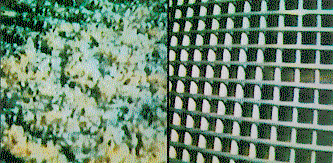Copper Screens Repel Clogging Mussels
Copper repels zebra mussels, a regional aggravation fast becoming a national menace. The incredibly fertile, thumbnail-size mollusks plug up pipes that conduct water to towns, factories and steam turbines. High copper alloy screens over the pipe intakes are one of the best antidotes, because the mussels don't adhere to the durable screens.
 These underwater photos compare screens over adjacent underwater intakes at a Consumers Power Company station in West Olive, Michigan. The stainless steel screen (left) is completely clogged with zebra mussels. The biostatic copper alloy screen (right) is almost completely free of mussels. It was fabricated by Wheelabrator.
These underwater photos compare screens over adjacent underwater intakes at a Consumers Power Company station in West Olive, Michigan. The stainless steel screen (left) is completely clogged with zebra mussels. The biostatic copper alloy screen (right) is almost completely free of mussels. It was fabricated by Wheelabrator.For the past year, Consumers Power Company, Jackson, Michigan, has been testing two copper alloy screens at its J.H. Campbell Plant No.3 in West Olive. According to Chris Hillman, an engineer with Consumers Power, the screens were "absolutely clean of zebra mussels after a year's service."
In contrast, the power plant's carbon and stainless steel screens must be scraped clean of zebra mussels at least once a year. This takes teams of divers about five days, a costly operation which runs about $3,500 per day.
Each test screen is made of a different high copper alloy, according to Lee Cook of Wheelabrator, which fabricated them. Just which allows were tested--and which was most effective--he would not reveal, explaining that "we have spent six years and about $150,000 figuring out which alloys are likely to work and also best resist corrosion." Cook did reveal, however, that 70-30 copper-nickel alloys and copper coatings are not as effective.
Insignificant Leaching
Tests show that leaching of the copper alloys into water is insignificant. This means the screens could also be used for municipal water systems.
Zebra mussels, which are not native to the Western Hemisphere, are believed to have entered the Great Lakes in bilge water discharged from freighters form Europe. The mussels proliferate at an awesome rate: each female produces from 30,000 to 4 0,000 eggs two to three times a year. They are now advancing on New York City and New Orleans and have crossed the Mississippi into the western states.
In Europe, native predators somewhat reduce the threat from the constricting mussels; in North America, only ducks relish zebra mussels. Other predators that eat zebra mussels have not been introduced into North America. According to biologist Don Lewis, manager of environmental sciences for Aquatic Sciences Inc., St. Catherines, Ontario, this is "because new, unanticipated problems could arise, which is what happened in the past." The Canadian consulting firm is investigating the use of ultraviolet light to kill the mussels. Other solutions under consideration are chemicals, such as chlorine or ozone, and electrolytic action.
The Russians have long used very hot water to periodically kill the mussels, according to consulting engineer Aivar Bergs, Willowdale, Ontario. They also tried ultrasound, but the vibrations destroyed underwater pipes they were supposed to save.
At Detroit Edison, hoses automatically deliver high pressure water every eight hours to dislodge the accretions from intake screens. "We also use very hot water to kill zebra mussels at our small plant in northern Michigan," noted Dr. Bill Kovalak. He's a biologist who first confronted the aggravating zebra mussels for Detroit Edison in 1988. Kovalak reported still another problem caused by the mussels: they eat so much plankton, clearing the water, that the sun's light penetrates deeper, stimulating heavy growth of weeds. The weeds also clog intakes.
The prototype screens supplied by Wheelabrator are 4 feet in diameter with a 4-foot deep sleeve. They weigh about two tons a piece. They are installed over the branch intakes to water pipes 18 feet in diameter extending 3,500 feet out along the lake bottom. The pipes have to be that long so they can't be damaged when ice breaks up in the spring and piles up along the shore. Power companies hope the screens last for 30 years, because of the high cost of divers to replace them.
Cook reports that many power companies have approached Wheelabrator after learning of the initial success of the screens--even though they cost as much as stainless steel screens, to which the mussels adhere like barnacles. To complement the screens, Whellabrator also offers the Hydroburst system to wash away debris that collects on the screens and a chemical disbursing system to kill any near-microscopic baby mussels that pass through the screen and attach themselves inside intake pipes.
Wheelabrator, Sturbridge, MA, 508/347-7049
Also in this Issue:
- Copper Screens Repel Clogging Mussels
- Copper Alloys Tools Prevent Dangerous Explosions
- Engine Renewal System Relies on Brass Fittings
- Copper Blocks RFI Both Ways
